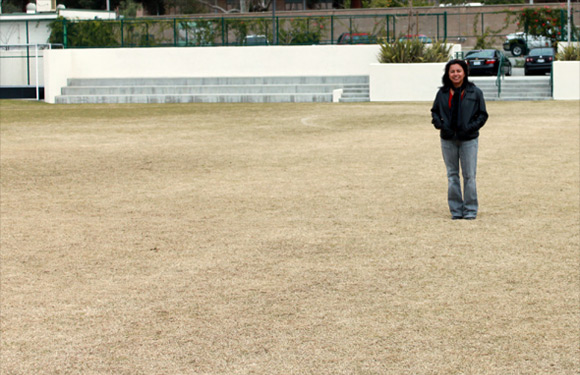
Bermuda grass is perfect for Scripps College’s Alumnae Field; it grows quickly and repairs itself between intense soccer or lacrosse scrimmages. The only drawback is aesthetic – typically dormant in the winter, Bermuda grass turns an unsightly brown during the cold winter months.
Other athletic fields are typically re-seeded and watered to allow for continuous growth until the weather in Claremont warms up. Lola Trafecanty, director of grounds and head of the Scripps College Sustainability Committee, had a better idea: let the grass take a rest.
“Students are gone from campus that time of year,” notes Lola. “It’s healthier for the grass and friendlier on the environment to not over-seed the field. The best part, is that the field is still usable when it is brown as this grass is on a sand base which allows for great percolation and no muddy damage.” Future plans for the field are to consider capturing rain water and re-using the water on the field during the hot summer months.
The proposal is great for the bottom line as well. Allowing the grass to go dormant lets it enter a natural cycle of growth while cutting costs on fertilizer, water, and field maintenance. When you consider the college saves 10,000 gallons of water a month keeping Alumnae Field brown, brown is suddenly very green.
“I think it’s great they’re saving water, money, and energy,” adds Rachel Darby ’13, who uses the field regularly for lacrosse practice.
Under Trafecanty’s direction, maintenance and grounds are adopting more “xeriscape” principles – landscaping approaches that reduce water usage by reducing turf grass, sticking to native plants, employing efficient irrigation, and having good soil drainage. A computerized irrigation system installed in the 1980s collects data from weather stations about rainfall, sunlight, and other factors that affect watering and adjust accordingly. The campus has also started to convert from spray to drip irrigation, which is more efficient and less expensive.
“Sustainability is the issue of the current generation,” says James Manifold, vice president of business affairs. As this issue increases in importance, Scripps is doing its best to stay on top of the technology. However, Trafecanty and her co-workers can’t do it alone.
“Any sustainable measures and policies we try out will not succeed without a strong community,” she says. By working with student interns and hearing student, staff, and faculty opinions on sustainability, there are hopes to further strengthen the green community at Scripps College. It seems only right that one of Forbes’ “World’s Most Beautiful College Campuses” should become one of the most environmentally-friendly campuses as well.

